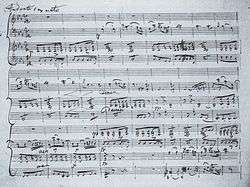Piano Trio No. 2 (Schubert)

The Trio No. 2 in E-flat major for piano, violin, and violoncello, D. 929, was one of the last compositions completed by Franz Schubert, dated November 1827. It was published by Probst as opus 100 in late 1828, shortly before the composer's death and first performed at a private party in January 1828 to celebrate the engagement of Schubert's school-friend Josef von Spaun. The Trio was among the few of his late compositions Schubert heard performed before his death.[1] It was given its first private performance by Carl Maria von Bocklet on the piano, Ignaz Schuppanzigh playing the violin, and Josef Linke playing cello.
Like Schubert's other piano trio, this is a comparatively larger work than most piano trios of the time, taking almost 50 minutes to perform. The second theme of the first movement is based loosely on the opening theme of the Minuet and Trio of Schubert's G major sonata (D. 894).
The main theme of the second movement was used as one of the central musical themes in Stanley Kubrick's 1975 film Barry Lyndon. It has also been used in a number of other films, including The Hunger, Crimson Tide, The Piano Teacher, L'Homme de sa vie, Land of the Blind, Dear White People, Recollections of the Yellow House, the HBO miniseries John Adams, The Mechanic, and as the opening piece for the ABC documentary The Killing Season.
Structure
The piano trio contains four movements:
Allegro
The first movement is in sonata form. There is disagreement over the break-up of thematic material with one source claiming six separate units of thematic material while another source divides them into three themes each with two periods. There is to an extent extra thematic material during the recapitulation. At least one of the thematic units is based closely on a theme in an earlier piano sonata. The development section focuses mainly on the final theme of the exposition.
Andante con moto
The second movement takes an asymmetrical-double-ternary form.

Scherzando. Allegro moderato
The scherzo is an animated piece in standard double ternary form.
Allegro moderato
The finale is in an uncommon form where Schubert layers the sonata form with the outline of rondo form. Schubert also includes in two interludes the opening theme of the second movement in an altered version.[2]
References
- ↑ Einstein, Alfred (1951). Schubert: A Musical Portrait. New York: Oxford University Press. p. 277.
- ↑ Christiansen, Kai (1997). "Piano Trio No. 2 in E-flat major, Op. 100, D. 929". Earsense.org. Retrieved 12 August 2016.
External links
- Piano Trio No. 2: Scores at the International Music Score Library Project
- Performance of Piano Trio No. 2 by the Claremont Trio from the Isabella Stewart Gardner Museum in M4A format
- Video performance of the 2nd movement by the Vienna Piano Trio